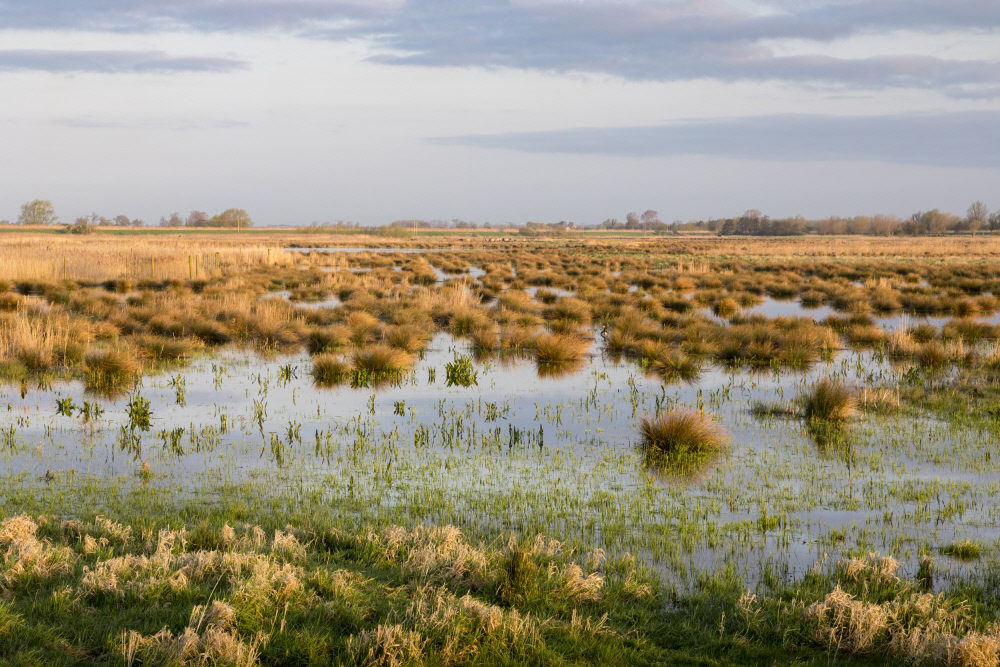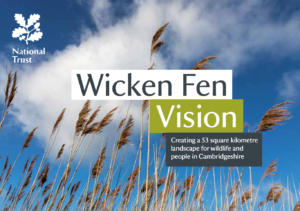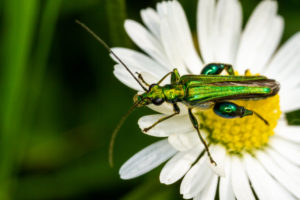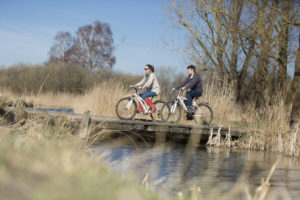Located in Cambridgeshire in eastern England, the 100-year Wicken Fen Vision project is working to acquire and rewild 53 square kilometres of drained fenland. Joining the European Rewilding Network will allow those involved to exchange insight and expertise and deliver improved results.

Lost landscape
Fenland (a type of marshy wetland) once covered much of the eastern English counties of Cambridgeshire, Lincolnshire and Norfolk. This unique low-lying landscape of slow, meandering rivers and streams, wet grasslands and woodlands, raised bogs and reedbeds was home to a hugely varied flora and fauna. Sadly, the vast majority of fenland has now been drained.
The National Trust, a British conservation and cultural heritage charity, has an ambitious plan to acquire and rewild a 53-square-kilometre area of former fenland by 2099. The aim of the Cambridgeshire-based Wicken Fen Vision project is to create a diverse landscape for wild nature and people stretching all the way from Wicken Fen, a fragment of remaining fenland, to the edge of Cambridge. This exciting initiative, which kicked off in 1999, has just become the European Rewilding Network’s newest member.
Enhancing rewilding

Based on rewilding principles, the Wicken Fen Vision is committed to giving nature the space it needs. The progressive rewetting of land and restoration of natural processes such as natural grazing (Highland cattle and Konik ponies already roam free on the fen) will see the landscape continue evolving into a mosaic of habitats that support a burgeoning array of wildlife.
With many European Rewilding Network (ERN) members engaged in large-scale landscape restoration and rewetting, membership will allow those involved in the Wicken Fen Vision project to exchange insight and expertise deliver enhanced results.
“I’m delighted that the Wicken Fen Vision has now registered with the ERN,” says Sarah Smith, the project’s general manager. “This will allow us to share the knowledge, skills and experience our team has gained over the first two decades of our 100-year plan, and to learn from like-minded experts across Europe as we go forwards.”
An expanding fragment

As a precious sliver of the once widespread fenland, Wicken Fen has developed into a rich oasis of life since becoming one of the UK’s first national nature reserves. Starting as a two-acre patch of fenland in 1899, a series of land purchases mean it now spans almost 2000 acres. It has also become a biodiversity hotspot: more than 9,300 species have been recorded here – more than anywhere else in the UK.
In the late 1990s it was decided that Wicken Fen was too small and isolated to guarantee the survival of its myriad rare species, particularly as it was coming under increasing pressure from visitors attracted to its wild nature and tranquillity, and the surrounding drained landscape. The Wicken Fen Vision was thus born, with the aim of significantly enlarging the Wicken Fen Nature Reserve through further land purchases, partnerships and subsequent rewilding.
Wildlife comeback
Since the Wicken Fen Vision project began, species such as cranes, Norfolk hawkers (a dragonfly) and otters have all returned after a decades-long absence, while the reserve frequently hosts up to 5000 wintering wildfowl. The fen is also home to many species that are endangered and nationally scarce in the UK, such as the cuckoo, bittern, marsh harrier, great crested newt, soprano pipistrelle bat, milk parsley and fen violet.
The peat at Wicken Fen is over five metres deep in places. Rewetting the landscape will also help to lock away as much as 80 per cent of the carbon stored in this peat, preventing it from entering the atmosphere and contributing to climate change.
The people perspective

The Wicken Fen Vision is creating and revitalising an environment that is bigger, better and more connected for people as well as nature. Visitors will be able to enjoy access and recreation across a beautiful, tranquil wilderness, with opportunities for volunteering, education and interpretation.
The Wicken Fen Visitor Centre already welcomes over 65,000 visitors each year. Bicycle hire, guided boat trips and a simple campsite are some of the ways visitors can engage with and learn about the local landscape and its wildlife.
ERN 2.0
Today rewilding is gaining momentum as a progressive and effective approach to conservation in Europe. Underpinning this trend, the burgeoning European Rewilding Network (ERN) continues to foster collaboration and amplify results.
Founded by Rewilding Europe in 2013, the aim of the ERN is to enhance the efforts of each member by facilitating the exchange of skills, insight and experience. Members meet regularly, usually via webinar, while nature-based businesses can also apply to Rewilding Europe Capital, Rewilding Europe’s enterprise loan facility.
The criteria for ERN membership have recently been revised, as the network shifts its focus from expansion to support for practical, result-oriented rewilding.
“The Wicken Fen Vision project typifies this kind of rewilding,” says ERN Coordinator Mei Elderadzi. “The initiative aligns with the new ERN criteria by scoring highly in its core objective of increasing interest in the wild.”
Rewilding Europe extends a warm welcome to all European rewilding initiatives and encourages them to apply for ERN membership.
About the National Trust
 The National Trust was founded in 1895 by three people who saw the importance of the UK’s heritage and open spaces, and wanted to preserve them for everyone to enjoy. More than 120 years later, these values are still at the heart of everything the charity does.
The National Trust was founded in 1895 by three people who saw the importance of the UK’s heritage and open spaces, and wanted to preserve them for everyone to enjoy. More than 120 years later, these values are still at the heart of everything the charity does.
Entirely independent of Government, the National Trust currently looks after more than 250,000 hectares of countryside, 778 miles of coastline and hundreds of special places across England, Wales and Northern Ireland. Almost 27 million people visit National Trust property every year, and together with more than 5.6 million members and over 65,000 volunteers, they help to support the charity in its work to care for special places forever, for everyone.
Want to know / experience more?
- The European Rewilding Network
- The Wicken Fen Vision member page
- Read more about the revised ERN admission criteria
- Rewilding Europe’s involvement with natural grazing
